Pup Development- Week Two
Days 8-14
| By day 8 the babies are covered with light fuzz. The eyeballs that you could once see through the sealed eyelids are now hidden by thicker and more opaque skin. They are still moving by squirming rather than actually crawling. They have limited use of their hind legs.
Breeders who have left the babies alone (except for occasionally checking their welfare) may start holding them more often as the second week progresses. |
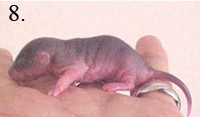 |
| If you compare the feet on days 9 and 10, you can see that the parts that will be white are pink and that areas that will have colored fur are darker. This may be hard to see if the color of the rat is light (such as in a silver or other highly-diluted rat). |  |
| Day 10 the ears become separated from the head. the pup rat still cannot hear, although it can sense vibrations.
It is getting easier to determine if the pup rats have dumbo or standard ear type. Dumbo ears will stick out and are located below the line of the eye. Standard ears are closer to the head, located above the eye line, and point upward. |
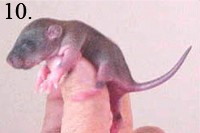 |
| On day 11, the feet have started to get fuzz on top of them. You can determine if the rat is a self (no white markings) as opposed to a marked rat such as a Berkshire by looking at the feet and the tails. Self rats have no white on their tails.
The eyes no longer protrude as much and look more like they are part of the head. |
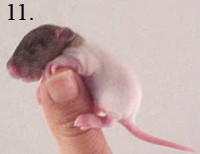 |
| On day 12 the ear canal opens and drains allowing the infant rats to hear. The babies are beginning to emerge from the nest. They are now walking, although a bit unsteadily at first.
The mother is still spending a lot of time nursing the babies. At this age the babies will usually not stop during a feeding session until all available milk is consumed. |
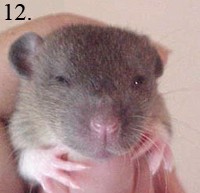 |
| As you can see on day 13, some of the babies’ eyes have started to open. From a pup’s point of view, things are blurry, but shadows may be visible. The babies who open their eyes early do not generally “see” any sooner than their siblings. | 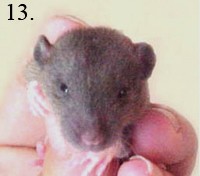 |
| By day 14 the babies are firmly on their way to being little rats. Fur completely covers their bodies, although they do not get guard hairs until much later.
When sexing babies at this age you still view the anogenital area, but you can now also check the abdomen for nipples (males do not have nipples) to help determine sex. |
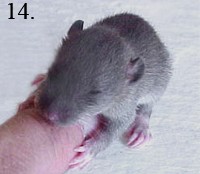 |
Photos by Joanne “Bella” Hodges


